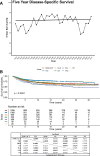Incidence and mortality of uveal melanoma in Australia (1982-2014)
- PMID: 34880052
- PMCID: PMC9985731
- DOI: 10.1136/bjophthalmol-2021-319700
Incidence and mortality of uveal melanoma in Australia (1982-2014)
Abstract
Aims: We aimed to estimate the incidence and mortality of uveal melanoma (UM) in Australia from 1982 to 2014.
Methods: Deidentified unit data for all cases of ocular melanoma were extracted from the Australian Cancer Database from 1 January 1982 to 31 December 2014. UM cases were extracted and trends in incidence and disease-specific mortality were calculated. Incidence rates were age-standardised against the 2001 Australian Standard Population. Mortality was assessed using Cox regression.
Results: From 1982 to 2014, there were 5087 cases of ocular melanoma in Australia, of which 4617 were classified as UM. The average age-standardised incidence rate of UM was 7.6 (95% CI 7.3 to 7.9) per million. There was an increase (p=0.0502) in the incidence of UM from 1982 to 1993 with an annual percent change (APC) of +2.5%, followed by a significant decrease in the incidence of UM from 1993 to 2014 (APC -1.2%). The average 5-year survival from 1982 to 2011 did not significantly change from an average of 81%, with an average APC (AAPC) of +0.1%. A multivariate Cox regression revealed that residence in Western Australia (p=0.001) or Tasmania (p=0.05), age ≥60 years (p<0.001) and histological classification as mixed (p<0.001) or epithelioid cells (p<0.001) were significantly associated with reduced survival.
Conclusion: In conclusion, we found that the incidence of UM peaked in the 1990s. Although treatment for primary UM has improved in the last 30 years, overall survival did not change significantly in the last 30 years.
Keywords: epidemiology; neoplasia.
© Author(s) (or their employer(s)) 2023. Re-use permitted under CC BY-NC. No commercial re-use. See rights and permissions. Published by BMJ.
Conflict of interest statement
Competing interests: None declared.
Figures


References
Publication types
MeSH terms
LinkOut - more resources
Full Text Sources
Medical
